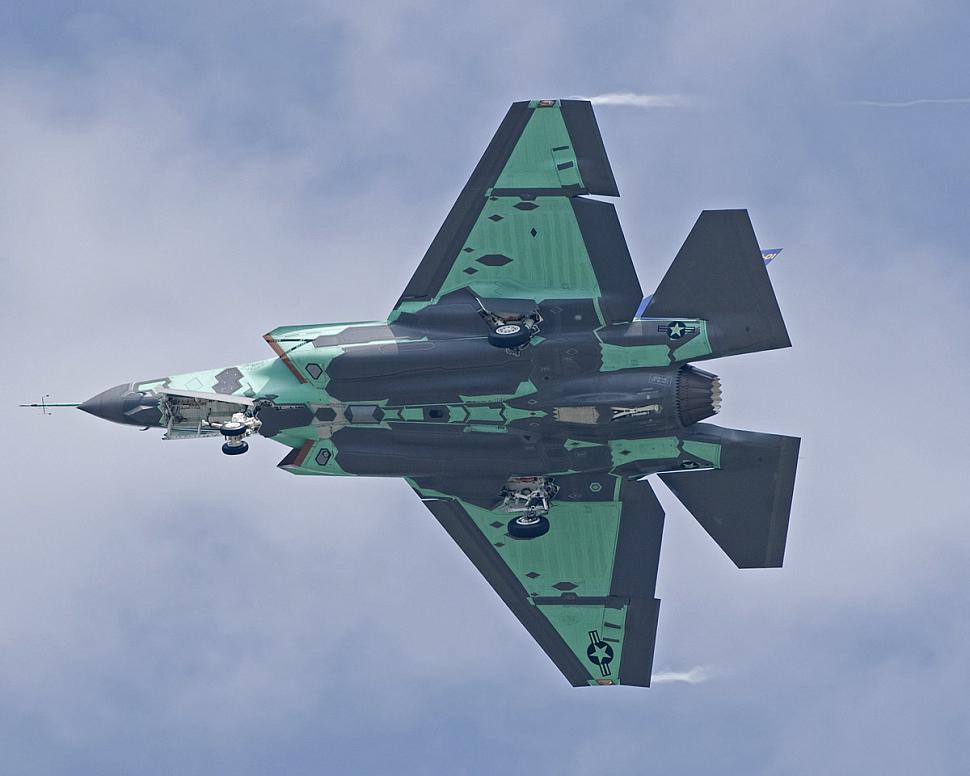Fighter Jet News
F-35 Lightning II News
F-35 testing ahead of schedule
July 13, 2010 (by
Bjørnar Bolsøy) -
The F-35 program continues an upwards trend as Lockheed delivers the last development jet, maintains its flight test schedule and prepares for additional first flights in the 3rd quarter.

The BF-5 STOVL jet rolled off the production lines on June 26 as the last of the 19 Systems Design and Development (SDD) jets. It will undergo systems checks and calibrations in preparation for first flight in the 3rd quarter. Preceding it will be AF-4, the fourth Air Force variant (CTOL), also scheduled for its first flight in 3rd quarter.
On Tuesday July 6 AF-3, the second "mission systems" jet, joined the seven jets currently flying at the program's three test sites. Currently over 1000 personnel are assigned to the flight testing at Fort Worth, NAS Patuxent River and Edwards AFB.
A program total of 289 flights have been logged - 83 since May 10. June was a productive month with 43 flights of 28 planned. Recent accomplishments include; short take off and vertical landing, supersonic flight, engine out operation and high angle of attack flights. By the first two weeks in July the program had completed 146 flights of 128 planned and 1,438 of 1,255 test points of the 2010 schedule.
Flight testing will continue to ramp up as new jets are delivered to meet the year-end-goal of 394 flights.
The U.S. Navy carrier variant, CF-1, made a twin flight on Wednesday July 7 and a 0.7 hour stortie on Monday July 12. It has flown 10 sorties since its June 6 inaugural flight. Meanwhile CG-1, the ground test aircraft, recently completed the carrier drop tests experiencing no structural failures or load exceedances. It follows CTOL and STOVL static tests, also recording no structural failures and completed in less than half the time of typical legacy fighter programs.
At PAX River BF-1 made two notable flights on June 30 and July 1, its 51st and 52nd. It accomplished the program's second vertical landing and first slow landing by a U.S. Marine Corps pilot, Lt. Col. Fred "Tinman" Schenk.
The CATBird - a modified 737 aircraft used as a flying test bed - is evaluating the F-35's Electro-Optical Targeting System (EOTS). The sensor is preparing to integrate on the "mission systems" jets, AF-3 and BF-4, with flight testing scheduled for 4th quarter. The EOTS was recently installed on the CATbird having previously flown on a Sabreliner aircraft since May 2007.
The sensor's laser device, used for range finding and laser spot tracking, was ground fired for the first time on June 29. The test firing was operated from the integrated F-35 cockpit located in the CATbird's main fuselage compartment. This arrangement allows for realistic tests in an airborne environment and, as such retires risk in the program's development phase. The CATBird has flown 115 sorties to date in support of the F-35 program.
The first EOTS-systems were delivered in August 2009 from Lockheed's Missiles and Fire Control production lines in Orlando, Florida.

CF-01 seen from below on flight 9 on July 7th, 2010. The second flight of the day. [Lockheed Martin photo by Carl Richards]
On Tuesday July 6 AF-3, the second "mission systems" jet, joined the seven jets currently flying at the program's three test sites. Currently over 1000 personnel are assigned to the flight testing at Fort Worth, NAS Patuxent River and Edwards AFB.
A program total of 289 flights have been logged - 83 since May 10. June was a productive month with 43 flights of 28 planned. Recent accomplishments include; short take off and vertical landing, supersonic flight, engine out operation and high angle of attack flights. By the first two weeks in July the program had completed 146 flights of 128 planned and 1,438 of 1,255 test points of the 2010 schedule.
Flight testing will continue to ramp up as new jets are delivered to meet the year-end-goal of 394 flights.
The U.S. Navy carrier variant, CF-1, made a twin flight on Wednesday July 7 and a 0.7 hour stortie on Monday July 12. It has flown 10 sorties since its June 6 inaugural flight. Meanwhile CG-1, the ground test aircraft, recently completed the carrier drop tests experiencing no structural failures or load exceedances. It follows CTOL and STOVL static tests, also recording no structural failures and completed in less than half the time of typical legacy fighter programs.
At PAX River BF-1 made two notable flights on June 30 and July 1, its 51st and 52nd. It accomplished the program's second vertical landing and first slow landing by a U.S. Marine Corps pilot, Lt. Col. Fred "Tinman" Schenk.
The CATBird - a modified 737 aircraft used as a flying test bed - is evaluating the F-35's Electro-Optical Targeting System (EOTS). The sensor is preparing to integrate on the "mission systems" jets, AF-3 and BF-4, with flight testing scheduled for 4th quarter. The EOTS was recently installed on the CATbird having previously flown on a Sabreliner aircraft since May 2007.
The sensor's laser device, used for range finding and laser spot tracking, was ground fired for the first time on June 29. The test firing was operated from the integrated F-35 cockpit located in the CATbird's main fuselage compartment. This arrangement allows for realistic tests in an airborne environment and, as such retires risk in the program's development phase. The CATBird has flown 115 sorties to date in support of the F-35 program.
The first EOTS-systems were delivered in August 2009 from Lockheed's Missiles and Fire Control production lines in Orlando, Florida.
Related articles:
Forum discussion:
Tags
- F-35A becomes second variant to fly with mission systems ( 2010-07-07)
- F-35C confirms Carrier-Landing strength predictions ( 2010-06-23)
- F-35 Lightning II news archive
Forum discussion:
- Start a discussion about this article in the F-35 forum.
Tags
